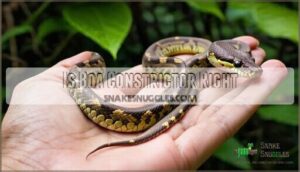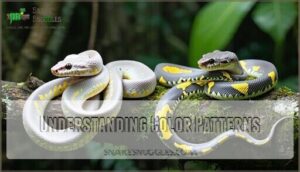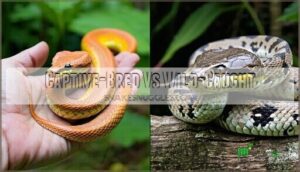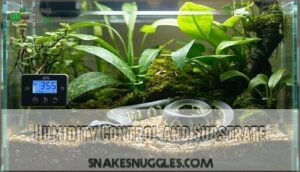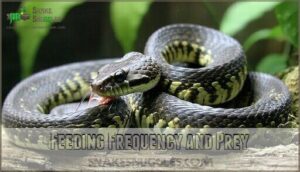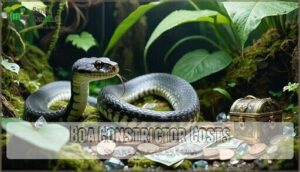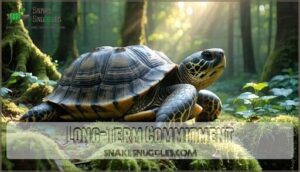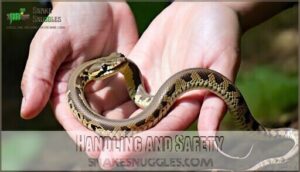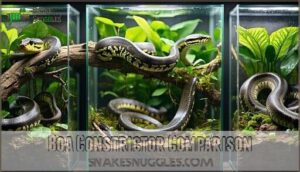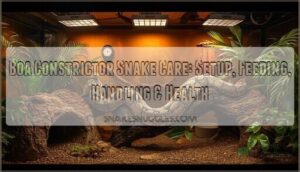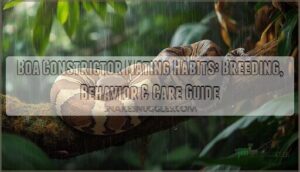This site is supported by our readers. We may earn a commission, at no cost to you, if you purchase through links.

You’ll need substantial space for a 10+ foot snake, expertise in maintaining precise temperature and humidity, and significant financial resources for proper setup and ongoing care.
These powerful constrictors require specialized knowledge, respect for their strength, and unwavering dedication to their complex needs.
Before deciding if a boa constrictor is right for your situation, you’ll want to understand the specific requirements that separate successful keepers from those who quickly become overwhelmed, which demands a high level of dedication.
Table Of Contents
Key Takeaways
- You’ll need extensive reptile experience, substantial financial resources ($500-2,000 upfront, $50-100 monthly), and space for a 10+ foot snake that can live 20-30 years
- These powerful constrictors require precise temperature gradients (88-92°F basking, 78-80°F cool side), 50-70% humidity, and specialized knowledge to maintain their complex environmental needs
- You can’t house multiple boas together since they’re solitary animals that compete for resources and become stressed, plus you’ll need to check local laws as many areas ban or require permits for ownership
- Your commitment spans decades with evolving care requirements, potential emergency veterinary costs reaching $500+, and the need for consistent feeding schedules and environmental monitoring throughout their entire lifespan
Boa Constrictor Basics
Before committing to a boa constrictor, you’ll need to understand these impressive serpents that can reach 10 feet long and live up to 30 years.
These non-venomous constrictors use powerful muscles to subdue prey, applying up to 25 PSI of pressure while monitoring their victim’s heartbeat to avoid unnecessary force, which makes them impressive serpents.
These powerful predators squeeze with bone-crushing force, sensing each heartbeat until their prey surrenders.
Biological Characteristics
Boa constrictors are impressive reptiles that’ll demand your respect and understanding.
These heavy-bodied, non-venomous snakes reach 6-13 feet in length and weigh 60-100 pounds, with sexual dimorphism making females markedly larger than males.
Key biological features include:
- Constriction pressure of 6-25 PSI that stops prey’s blood flow within seconds
- Independent rib movement allowing breathing while squeezing prey
- Camouflage patterns featuring bars, diamonds, and circles on varied backgrounds
- Arboreal behavior in juveniles, becoming terrestrial as adults
- Lifespan of 20-30 years wild, up to 40 years captive
Behavior and Habitat
Understanding your boa’s natural behavior helps you create the right environment for success.
These snakes display fascinating arboreal behavior when young, spending time in trees before shifting to ground-dwelling as adults.
| Age Stage | Habitat Preference |
|---|---|
| Juvenile | Trees and branches |
| Young Adult | Mixed arboreal/terrestrial |
| Adult | Ground level |
| Senior | Burrows and logs |
Boa constrictor habitat spans from Mexico to South America, showcasing remarkable habitat diversity across rainforests, savannas, and semi-desert regions.
Their temperament differences become apparent when threatened – while generally peaceful, they’ll deliver defensive strikes when cornered.
Shelter preferences include hollow logs and abandoned burrows, reflecting their need for security.
Understanding snake behavior in their natural habitat guides proper boa constrictor handling and helps you recognize normal versus stressed behaviors in captivity.
Diet and Prey
Wild boa constrictors hunt diverse prey including mammals, birds, lizards, and amphibians.
Your pet’s boa constrictor diet should mirror this variety through appropriately-sized frozen-thawed rodents.
Juveniles need smaller prey every 7-10 days, while adults eat larger meals every 2-4 weeks.
A key aspect includes calcium and vitamin D supplementation for bone health.
Proper prey size matches your snake’s widest body section, ensuring safe digestion and healthy feeding habits with the right prey size and calcium intake.
Is Boa Constrictor Right
Deciding whether you’re ready for boa constrictor ownership requires honest self-assessment.
These snakes aren’t starter pets – they demand decades of commitment, specialized knowledge, and substantial financial investment.
Constrictor temperament varies markedly between individuals, making each snake unique in handling requirements and personality.
Responsible reptile keeping means understanding boa conservation implications.
Wild populations face habitat loss, making captive-bred specimens the ethical choice.
Boa ownership ethics extend beyond personal desires to take into account the animal’s welfare throughout its 20-30 year lifespan.
Your living situation must accommodate a large boa constrictor enclosure – adults need 6-8 feet minimum.
Captivity concerns include maintaining proper humidity, temperature gradients, and handling stress.
Boa constrictor care isn’t just feeding and cleaning; it’s monitoring health, recognizing behavioral changes, and providing environmental enrichment.
Consider your long-term stability, as job changes, moves, or family additions can complicate snake temperament and care consistency.
Choosing a Pet Boa
Choosing the right boa isn’t just about finding a pretty snake—it’s about matching your lifestyle with a specific animal’s needs and temperament.
You’ll want to research different subspecies, understand their unique characteristics, and decide between captive-bred and wild-caught options before making this long-term commitment.
Researching Different Species
When choosing among over 20 subspecies, you’ll discover fascinating Morph Variations and Locality Boas that dramatically affect your pet snake experience.
Dwarf Boas from islands stay manageable at 4-6 feet, while mainland varieties reach 10+ feet.
Temperament Differences between subspecies matter substantially—Hog Island boas show remarkable docility compared to more defensive Central American types.
Hybrid Boas offer unique traits but require careful reptile care research, and your snake species selection impacts decades of snake temperament interactions, so thorough pet research pays off.
Understanding Color Patterns
Boa constrictor morphs showcase stunning diversity through selective breeding and pattern genetics.
You’ll find regional variations from Central America’s vibrant reds to South America’s earthy tones.
Popular morphs include albino, anery, and jungle patterns, each offering unique morph characteristics.
These color patterns provide natural camouflage benefits in wild habitats while creating breathtaking pet snake varieties through careful breeding programs.
Captive-Bred Vs Wild-Caught
Captive-bred boas offer significant advantages over wild-caught specimens.
Health concerns plague wild-caught animals, which often carry parasites and diseases that captive-bred snakes rarely develop.
Temperament variations show captive-bred boas adapt better to handling, while wild-caught specimens display increased aggression.
Ethical sourcing supports conservation impact by reducing pressure on wild populations.
Responsible ownership means choosing captive-bred animals despite higher initial costs, as they require fewer veterinary interventions and demonstrate superior longevity in captivity.
Choosing captive bred also reduces the risk of pathogen transmission due to reduced pressure on wild populations.
Boa Constrictor Care
Once you’ve decided a boa constrictor is right for you, proper care becomes your most important responsibility.
Creating the right environment with correct temperature, humidity, and feeding schedules will determine your snake’s health and happiness for decades to come.
Humidity Control and Substrate
Creating proper boa constrictor humidity and substrate conditions prevents health problems down the road.
You’ll need to maintain 50-70% humidity using a reliable hygrometer for accurate readings. Consider using a specialized boa hygrometer for superior performance.
Choose substrates like aspen shavings or coconut husk that retain moisture without promoting mold growth. These materials support successful shedding while allowing easy spot-cleaning when your snake eliminates waste.
Feeding Frequency and Prey
Your boa constrictor’s feeding schedule depends on age and size. Feed hatchlings every 5-7 days, juveniles every 7-10 days, and adults every 14-21 days.
Frozen-thawed prey prevents injuries and disease transmission while providing excellent prey nutritional value. Proper feeding schedule adjustments prevent obesity and maintain your snake’s health.
Knowing a boa’s digestion time considerations helps prevent regurgitation. Choose appropriately sized rodents—never exceeding your boa’s midbody girth for safe digestion.
Enclosure Size and Temperature
After setting up your boa constrictor’s home, proper enclosure dimensions and heating methods become vital for your snake’s health.
Adults need at least 6-8 feet of space, while maintaining specific temperature requirements guarantees comfort and proper digestion.
Selecting the right boa enclosure products is essential for creating a suitable habitat.
Essential temperature control requirements:
- Basking spot: 88-92°F using ceramic heat emitters or heat lamps
- Cool side: 78-80°F for proper temperature gradient creation
- Nighttime: 75-78°F with thermostat control preventing overheating
- Humidity: 50-70% maintained through water bowls and misting
- Seasonal adjustments: Slight cooling during winter months mimics natural cycles
Boa Constrictor Costs
Before you invest in a boa constrictor, you’ll need to budget for significant upfront and ongoing expenses that can quickly add up.
Understanding these financial commitments helps determine if you’re truly prepared for this long-term investment that’ll span decades of your life.
Before you invest in a boa constrictor, you’ll need to budget for significant upfront and ongoing expenses that can quickly add up.
Understanding these financial commitments helps determine if you’re truly prepared for this long-term investment that’ll span decades of your life, considering the significant upfront and ongoing expenses.
Initial Investment and Ongoing Costs
Your financial commitment begins with the initial purchase price, ranging from $150 to $1,500 depending on the snake’s morph and breeder reputation.
Your snake’s price tag reflects years of careful breeding, health screening, and genetic selection that creates these stunning morphs.
Habitat expenses include a proper enclosure ($200-$400), heating systems ($75-$150), and décor ($50-$100).
Monthly feeding costs average $15-$30 for frozen rodents, while veterinary care starts at $60-$120 for initial exams.
Many owners also consider the boa constrictor’s cost when budgeting, and these ongoing expenses add up quickly over your snake’s 20-30 year lifespan.
Budgeting and Financial Considerations
Smart budgeting separates successful boa ownership from financial stress. You’ll need $500-2,000 upfront, then $50-100 monthly for food and supplies. Veterinary care costs $100-300 annually, but emergency visits can reach $500.
Build an emergency fund covering six months of expenses before bringing your snake home.
- Create a monthly boa budget including food ($20-40), utilities ($15-25), and replacement supplies ($10-20)
- Set aside $300-500 annually for routine veterinary checkups and preventive health screenings
- Establish an emergency fund of $1,000-2,000 for unexpected medical costs or equipment failures
Local Regulations and Laws
Before bringing home your dream boa, you’ll need to navigate the legal maze that varies dramatically from state to state and city to city.
Some areas welcome these impressive constrictors with open arms, while others have banned them entirely or require special permits that can take months to obtain.
Ownership Legality and Permits
Permit-navigation becomes essential when owning a boa constrictor legally.
Over fifteen states prohibit or require permits for boa ownership, with penalties reaching $5,000. Local ordinances often mandate exotic animal permits, home inspections, and annual renewal fees ranging from $25-$300.
Research your area’s specific requirements before purchasing.
| Regulation Level | Requirements | Penalties |
|---|---|---|
| State Regulations | Permits/bans vary by state | Fines up to $5,000 |
| Local Ordinances | City permits, inspections | Animal confiscation |
| Permit Requirements | Annual renewals, fees | Legal compliance issues |
| Banned Species | Size restrictions apply | Criminal charges possible |
| Legal Compliance | Documentation needed | Wildlife agency action |
Compliance With Fish and Wildlife
You’ll need to navigate Federal Regulations and Import Restrictions when acquiring your boa constrictor.
These US pet laws help prevent Invasive Species problems while supporting Conservation Efforts. Legal pet ownership requires understanding permit requirements and importexport rules for Ethical Sourcing.
- Check CITES permits for imported specimens
- Verify state wildlife agency compliance requirements
- Research local exotic animal transportation regulations
Long-Term Commitment
Owning a boa constrictor isn’t just a casual pet decision—it’s a commitment that can span decades of your life.
With lifespans reaching 20-30 years in the wild and up to 40 years in captivity, you’ll potentially share your home with this snake longer than many people keep dogs or cats.
Responsibility and Time Investment
Owning a boa constrictor means accepting a daily commitment that’ll reshape your lifestyle for decades.
You’ll spend time monitoring temperatures, humidity levels, and feeding schedules while managing space requirements that grow with your snake.
This pet commitment demands consistent financial planning alongside long-term care responsibilities.
Your social life, travel plans, and living arrangements must accommodate these longterm commitment needs, making ethical considerations about your readiness paramount.
Boa Constrictor Lifespan and Care
A boa constrictor lifespan stretches 20-30 years in the wild, extending to 30-40 years in captivity with proper care.
This long-term commitment requires consistent attention to their evolving needs throughout different life stages. Captive boas can even exceed these estimates, with some experiencing remarkable longevity.
Key lifespan considerations:
- Enclosure Enrichment – Older boas need larger spaces and climbing structures as they grow
- Shedding Problems increase with age, requiring humidity adjustments and veterinary care monitoring
- Temperament Changes occur naturally – handling frequency should adapt to your snake’s comfort level over decades
Your boa constrictor setup, feeding schedule, and health monitoring will evolve substantially over their lifetime.
Handling and Safety
Proper handling techniques guarantee your safety and your boa’s wellbeing during interactions. Understanding common health risks helps you recognize early warning signs and maintain your snake’s long-term health.
Safe Handling Practices and Techniques
Building trust requires consistent, calm movements and proper support for your snake’s entire body.
When approaching your boa, move slowly and avoid sudden gestures that trigger defensive responses.
Always support both the head and body sections during handling sessions to prevent stress or injury.
| Do This | Avoid This |
|---|---|
| Support the snake’s full body weight | Grab only the head or tail |
| Move slowly and deliberately | Make sudden, jerky movements |
| Handle during daylight hours | Disturb during shedding periods |
| Watch for stress signals like hissing | Force interaction when snake seems agitated |
| Keep sessions brief (10-15 minutes) | Handle immediately after feeding |
Common Health Issues and Risks
Several health challenges can threaten your boa’s well-being, with respiratory infections affecting 15-20% of captive specimens.
Understanding these common diseases helps you provide proper preventative care and recognize when veterinary care becomes necessary.
- Respiratory Infections – Poor humidity and temperature control trigger wheezing and mouth breathing
- Scale Rot – Excessive moisture causes skin deterioration and bacterial growth
- Parasites – Internal worms and external mites affect 20-30% of wild-caught specimens
- Inclusion Body Disease – Viral threat detected in 25% of poorly managed collections
- Quarantine Protocols – Isolate new snakes for 30-90 days to prevent disease transmission
Boa Constrictor Comparison
Choosing the right constrictor snake means understanding the key differences between boas, pythons, and anacondas.
You’ll want to compare their size requirements, strength levels, and temperament differences to make an informed decision about which species fits your experience level and living situation.
Boa Vs Python and Anaconda
Understanding the differences between these giant snakes helps you make informed decisions about pet ownership.
While they’re often confused, boas, pythons, and anacondas represent distinct evolutionary paths with unique care requirements.
| Feature | Boa Constrictor | Python | Anaconda |
|---|---|---|---|
| Size Range | 6-10 feet average | 3-33 feet varying | Up to 30 feet |
| Geographic Origin | Americas | Africa/Asia/Australia | South America |
| Reproduction | Live birth | Egg-laying | Live birth |
| Habitat Preference | Terrestrial/semi-arboreal | Varies by species | Aquatic |
| Pet Suitability | Good for beginners | Species dependent | Not recommended |
Python comparison reveals significant habitat overlap differences, with boas thriving in American environments while pythons dominate Old World regions.
One key distinction lies in their reproductive strategies, as boas typically exhibit live birth, while pythons are known for laying eggs.
Python and boa relation shows convergent evolution rather than close ancestry.
Anaconda pet ownership presents extreme care complexity due to their aquatic nature and massive size.
Strength differences between species relate directly to their hunting strategies, with anacondas requiring the most power for aquatic prey capture.
Size, Strength, and Temperament Comparison
When comparing these powerful constrictors, you’ll find significant differences in boa constrictor size, snake strength, and temperament traits that directly impact your pet ownership experience.
The following table highlights key differences between boa constrictors and pythons/anacondas:
| Feature | Boa Constrictor | Python/Anaconda |
|---|---|---|
| Average Size | 6-10 feet, 60-100 lbs | Pythons: 15-20+ feet; Anacondas: 20-29 feet |
| Boa Strength | 6-25 PSI constriction force | Higher PSI due to larger size |
| Species Docility | Generally calm, tolerates handling | Varies; anacondas aggressive |
| Handling Difficulty | Moderate with proper technique | High due to size and power |
| Temperament Traits | Predictable, defensive when threatened | More unpredictable, species-dependent |
These differences are crucial for potential pet owners to consider, as they significantly affect the overall experience of caring for these snakes.
Frequently Asked Questions (FAQs)
What can a boa constrictor do to a human?
Don’t bite off more than you can chew—a boa constrictor can deliver a painful, non-venomous bite and potentially constrict you, but they’re generally docile and rarely dangerous to humans.
How painful is a boa constrictor bite?
A boa constrictor’s bite feels like sharp needles piercing your skin, causing immediate pain and bleeding. You’ll experience throbbing discomfort for several hours, but it’s rarely dangerous to humans.
Can boa constrictors swim or live near water?
Yes, you’ll find that boa constrictors are excellent swimmers and can be found near rivers and streams.
However, they prefer staying on dry land in hollow logs or abandoned burrows rather than spending time in water.
Do boas shed their skin like other snakes?
Like nature’s wardrobe changing seasons, you’ll find that boas regularly shed their skin in complete pieces.
This molting process happens every few months, helping them grow and stay healthy throughout their lives.
How often should you clean boa enclosures?
You’ll want to spot-clean your boa’s enclosure weekly, removing waste and uneaten food immediately. Complete substrate changes should happen monthly, though high-humidity setups may need more frequent attention.
Can multiple boas live together safely?
Looking for roommates for your boa? Unfortunately, you shouldn’t house multiple boas together.
They’re naturally solitary creatures that compete for resources, become stressed, and may injure each other.
Separate enclosures guarantee each snake’s health and happiness.
What vaccinations do pet boas need?
Pet boa constrictors don’t require vaccinations like traditional pets.
Unlike dogs and cats, snakes aren’t susceptible to diseases prevented by vaccines.
Instead, you’ll focus on proper husbandry, regular health monitoring, and veterinary checkups for peak health, which includes regular health monitoring.
Conclusion
Carefully weigh whether you’re prepared for decades of dedicated care, substantial financial investment, and the specialized knowledge these magnificent constrictors demand.
A boa constrictor isn’t right for casual pet owners or those seeking low-maintenance companions.
However, if you possess extensive reptile experience, adequate housing space, consistent financial resources, and genuine commitment to proper husbandry, these remarkable serpents can provide rewarding long-term partnerships.
Your decision should prioritize the animal’s welfare over personal desires, ensuring you can meet their complex needs throughout their entire lifespan, and provide the necessary care for a rewarding experience.
- https://pmc.ncbi.nlm.nih.gov/articles/PMC9602588/
- https://www.boa-constrictors.com/en/Interesting_facts_about_Boa_constrictor/Boa_constrictor_Care/diseases
- https://www.biorxiv.org/content/10.1101/2022.04.25.489483v1.full.pdf
- https://www.reptiles.swelluk.com/help-guides/wild-caught-reptiles-or-captive-bred-and-why/
- https://happilygus.com/is-a-boa-constrictor-the-best-pet-for-you/

